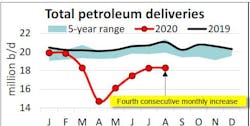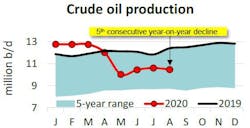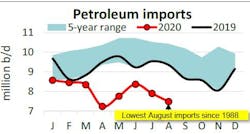API: US petroleum demand continued to increase in August
US petroleum demand increased in August, and supply decreased, while Gulf Coast refineries, petrochemical plants, and export terminals coped with seasonal disruptions due to Hurricane Laura, according to the American Petroleum Institute data.
Crude oil and refined product exports increased during the month, while imports fell. Together these fundamentals contributed to lower crude oil stocks (but higher refined product inventories) and higher prices against an economic backdrop that has broadly improved.
Demand
US petroleum demand, as measured by total domestic petroleum deliveries, was 18.3 million b/d in August. This reflected a 0.2% increase from July but a decrease of 13.6% (2.9 million b/d) below August 2019 levels. The rebound since April has amounted to 3.6 million b/d so far with motor gasoline accounting for 82% of the recovery from the COVID-19 pandemic.
Consumer gasoline demand, measured by motor gasoline deliveries, was 8.8 million b/d in August. This was a monthly increase of 1.5% (0.1 million b/d) but remained 10.4% (1.0 million b/d) below year-ago levels.
Although gasoline demand rose from July, the deficit versus year-ago levels appeared wider due to lower-than-normal summer driving seasonality. Low gasoline prices have continued to support demand. The US average conventional gasoline price held steady at $2.27/gal in August, down by 16.1% ($0.44/gal) from August 2019, according to AAA.
In August, distillate deliveries of 3.7 million b/d rose by 4.2% from July but were down by 8.1% y/y (0.3 million b/d). This was consistent with DAT iQ industry trendlines showing increased spot trucking loads.
Jet fuel deliveries of 1.0 million b/d in August fell by 1.5% m/m and remained down by 46.4% from August 2019 – the most adversely impacted fuel due to the COVID-19 pandemic. The relatively slow recovery in jet fuel deliveries has been consistent with weakened reported flight activity and passenger demand per Flightradar24 and TSA.
Deliveries of residual fuel oil, which is used in electric power production, space heating, industrial applications and as a marine bunker fuel, fell to 0.3 million b/d in August. This marked decrease of 24.6% m/m and 10.6% y/y, respectively, consistent with weak industrial activity and lower marine demand due to IMO 2020 implementation compounded by the effects of the COVID-19 pandemic.
Macroeconomy
The Institute for Supply Management’s Purchasing Managers Index (PMI), came in with a reading of 56.0 in August. Index values above 50.0 suggest an expansion. Production and new orders rose. Export sales grew, raw materials inventories decreased, and prices increased. Among the 18 manufacturing industries covered, 15 reported expansions in August.
Furthermore, consumer sentiment continued its improvement, while remaining at historically weak levels in August per the University of Michigan’s consumer sentiment index. Since a reading of 101.0 in February, the index fell as low as 71.8 in April and rebounded to 74.1 in August. The survey noted that consumers were slightly more optimistic about future economic and personal finance expectations. However, the survey also indicated a continued weakness in buying conditions - even with low interest rates - and highlighted a need for additional fiscal policies.
According to the Bureau of Labor Statistics (BLS), non-farm payrolls increased by 1.4 million, and the unemployment rate fell to 8.4% in August from 10.2% in July, indicating a resumption of economic activity along with recovery from the COVID-19 pandemic.
Supply
In August, US crude oil production was 10.5 million b/d, a decrease of 1.4% (0.1 million b/d) from revised July data amid less drilling activity. Oil-directed drilling activity (178 rigs in August) fell to its lowest levels since November 2001 per Baker Hughes. However, drilling productivity rose to record highs among most producing basins per EIA.
Similarly, US natural gas liquids (NGLs) decreased by 2.6% m/m (0.1 million b/d) to 4.7 million b/d. Natural gas related NGLs production has held up relatively well through the COVID-19 pandemic.
Trade
Following three months of petroleum net imports, the US returned to being a net exporter in August by a small margin. Specifically, the US imported 7.5 million b/d of crude oil and petroleum products in August. This was a decrease of 5.3% m/m (0.4 million b/d) from July, with EIA weekly data suggesting that imports from Saudi Arabia fell to their lowest levels since 2010.
By contrast, US exports of crude oil and refined products totaled 7.8 million b/d, implying US petroleum net exports of 0.3 million b/d in August. Gross exports rose by 2.0% (0.2 million b/d) from July but were down by 7.5% (0.6 million b/d) compared with August 2019. Within the exports, 4.8 million b/d was refined products, which increased by 1.9% m/m, and the remaining 3.0 million b/d was crude oil that rose by 0.1 million b/d m/m to a record for the month of August.
Refining, inventories
US refinery throughput of 14.8 million b/d implied a capacity utilization rate of 79.6% in August. Refinery throughput decreased by 0.5% m/m while capacity utilization rose by 1.0 percentage point, as operable crude distillation unit capacity decreased in August. About 13% of US refining capacity was temporarily shut-in due to Hurricane Laura affecting the Gulf Coast.
US total petroleum inventories, including crude oil and refined products but excluding the Strategic Petroleum Reserve were 1.46 billion bbl in August. This was the highest month on record since 1956, increasing 0.2% from July and, notably, 13.2% since the onset of COVID-19 in March. Within the total, crude oil stocks of 502.8 million fell by 3.3% m/m and stand 6.6% m/m below the record in March 2017.


